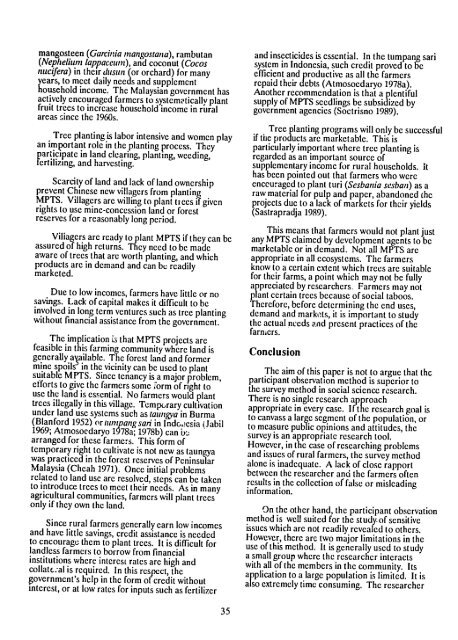multipurpose tree species research for small farms: strategies ... - part
multipurpose tree species research for small farms: strategies ... - part
multipurpose tree species research for small farms: strategies ... - part
You also want an ePaper? Increase the reach of your titles
YUMPU automatically turns print PDFs into web optimized ePapers that Google loves.
mangosteen (Garciniamnangostana), rambutan<br />
(Nephelium lappaceumn), and coconut (Cocos<br />
nucifera) in their dusun (or orchard) <strong>for</strong> many<br />
years, to meet daily needs and supplement<br />
household income. The Malaysian government has<br />
actively encouraged farmers to systematically plant<br />
fruit <strong>tree</strong>s to increase household income in rural<br />
areas since the 1960s.<br />
Tree planting is labor intensive and women play<br />
an important role in the planting process. They<br />
<strong>part</strong>icipate in land clearing, planting, weeding,<br />
fertilizing, and harvesting.<br />
Scarcity of land and lack of land ownership<br />
prevent Chinese new villagers from planting<br />
MPTS. Villagers are willing to plant tiees if given<br />
rights to use mine-concession land or <strong>for</strong>est<br />
reserves <strong>for</strong> a reasonably long period.<br />
Viliagers are ready to plant MPTS if they can be<br />
assured of high returns. They need to be made<br />
aware of <strong>tree</strong>s that are worth planting, and which<br />
products are in demand and can bt readily<br />
marketed.<br />
Due to low incomes, farmers have little or no<br />
savings. Lack of capital makes itdifficult to be<br />
involved in long term ventures such as <strong>tree</strong> planting<br />
without financial assistance from the government,<br />
The implication isthat MPTS projects are<br />
feasible in this farming community where land is<br />
generally agilable. The <strong>for</strong>est land and <strong>for</strong>mer<br />
mine spoils in the vicinity can be used to plant<br />
suitable MPTS. Since tenancy isa major problem,<br />
ef<strong>for</strong>ts to give the farmers some 'orm of right to<br />
use the land is essential. No farmers would plant<br />
<strong>tree</strong>s illegally in this village. Temporary cultivation<br />
under land use systems such as taungya in Burma<br />
(Blan<strong>for</strong>d 1952) or tumpangsari in Ind,,.,esia (Jabil<br />
1969; Atmosoedaryo 1 9 78a; 1978b) can w;survey<br />
arranged <strong>for</strong> these farmers. This <strong>for</strong>m of<br />
temporary right to cultivate is not new as taungya<br />
was practiced in the <strong>for</strong>est reserves of Peninsular<br />
Malaysia (Cheah 1971). Once initial problems<br />
related to land use are resolved, steps can be taken<br />
to introduce <strong>tree</strong>s to meet their needs. As in many<br />
agricultural communities, farmers will plant <strong>tree</strong>s<br />
only if they own the land.<br />
Since rural farmers generally earn low incomes<br />
and have little savings, credit assistance is needed<br />
to encourage them to plant <strong>tree</strong>s. It is difficult <strong>for</strong><br />
landless farmers to borrow from financial<br />
institutions where interest rates are high and<br />
collatc.-al is required. In this respect, the<br />
government's help in the <strong>for</strong>m of credit without<br />
interest, or at low rates <strong>for</strong> inputs such as fertilizer<br />
35<br />
and insecticides is essential. In the tumpang sari<br />
system in Indonesia, such credit proved to be<br />
efficient and productive as all the farmers<br />
repaid their debts (Atmosoedaryo 1978a).<br />
Another recommendation is that a plentiful<br />
supply of MPTS seedlings be subsidized by<br />
government agencies (Soetrisno 1989).<br />
Treeplanting programs will only be successful<br />
if tie products are marketable. This is<br />
<strong>part</strong>icularly important where <strong>tree</strong> planting is<br />
regarded as an important source of<br />
supplementary income <strong>for</strong> rural households. It<br />
has been pointed out that farmers who were<br />
encouraged to plant turi (Sesbania sesban) as a<br />
raw material <strong>for</strong> pulp and paper, abandoned the<br />
projects due to a lack of markets <strong>for</strong> their yields<br />
(Sastrapradja 1989).<br />
This means that farmers would not plant just<br />
any MPTS claimed by development agents to be<br />
marketable or in demand. Not all MPTS are<br />
appropriate in all ecosystems. The farmers<br />
know to a certain extent which <strong>tree</strong>s are suitable<br />
<strong>for</strong> their <strong>farms</strong>, a point which may not be fully<br />
appreciated by <strong>research</strong>ers. Farmers may not<br />
plant certain <strong>tree</strong>s because of social taboos.<br />
There<strong>for</strong>e, be<strong>for</strong>e determining the end uses,<br />
demand and marki-ts, it is important to study<br />
the actual needs and present practices of the<br />
farmers.<br />
Conclusion<br />
The aim of this paper is not to argue that the<br />
<strong>part</strong>icipant observation method is superior to<br />
the survey method insocial science <strong>research</strong>.<br />
There isno single <strong>research</strong> approach<br />
appropriate in every case. If the <strong>research</strong> goal is<br />
to canvass a large segment of the population, or<br />
to measure public opinions and attitudes, the<br />
is an appropriate <strong>research</strong> tool.<br />
However, inthe case of <strong>research</strong>ing problems<br />
and issues of rural farmers, the survey method<br />
alone is inadequate. A lack of close rapport<br />
between the <strong>research</strong>er and the farmers often<br />
results in the collection of false or misleading<br />
in<strong>for</strong>mation.<br />
On the other hand, the <strong>part</strong>icipant observation<br />
method is well suited <strong>for</strong> the study.of sensitive<br />
issues which are not readily revealed to others.<br />
However, there are two major limitations in the<br />
use of this method. It isgenerally used to study<br />
a <strong>small</strong> group where the <strong>research</strong>er interacts<br />
with all of the members in the community. Its<br />
application to a large population islimited. It is<br />
aIso extremely time consuming. The <strong>research</strong>er

















